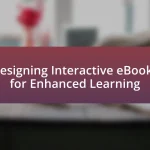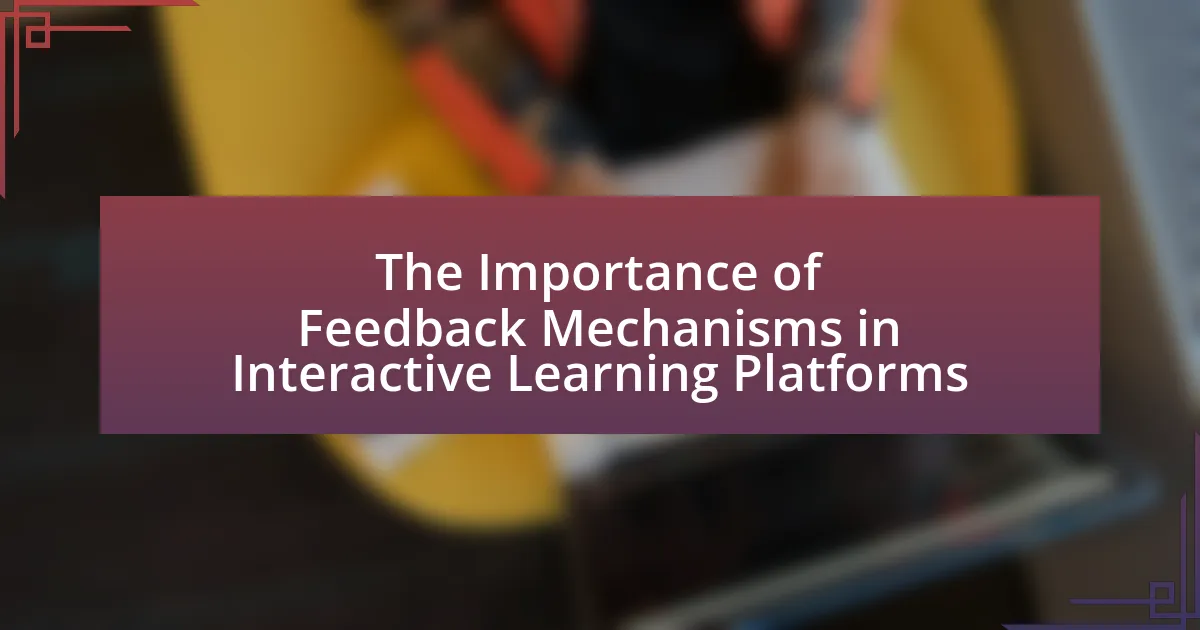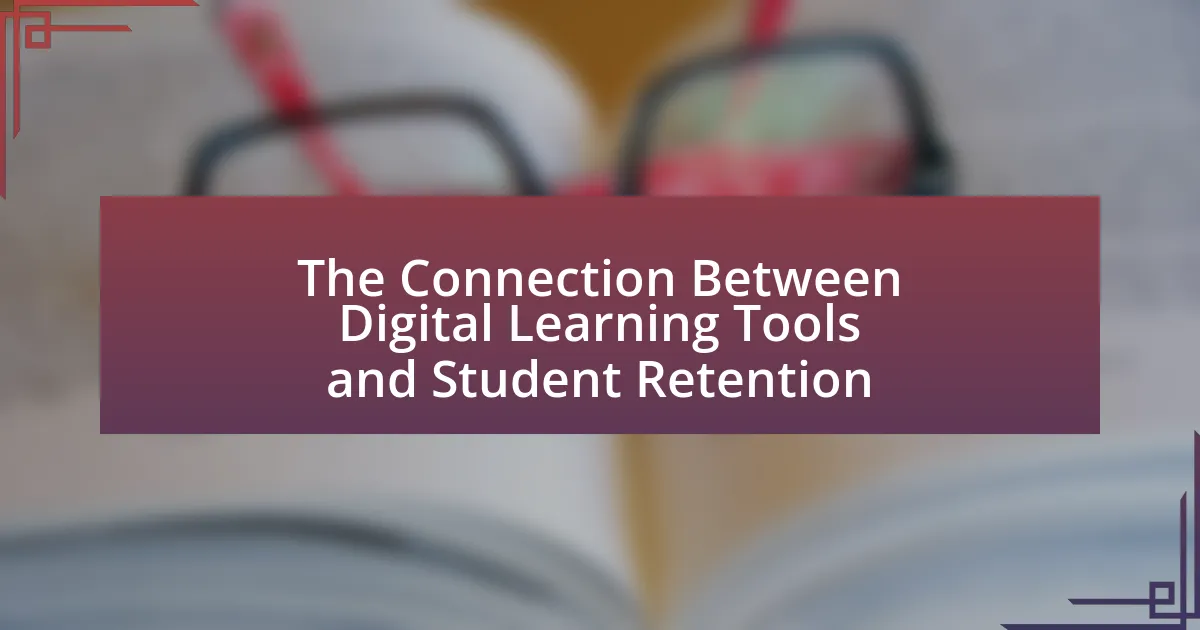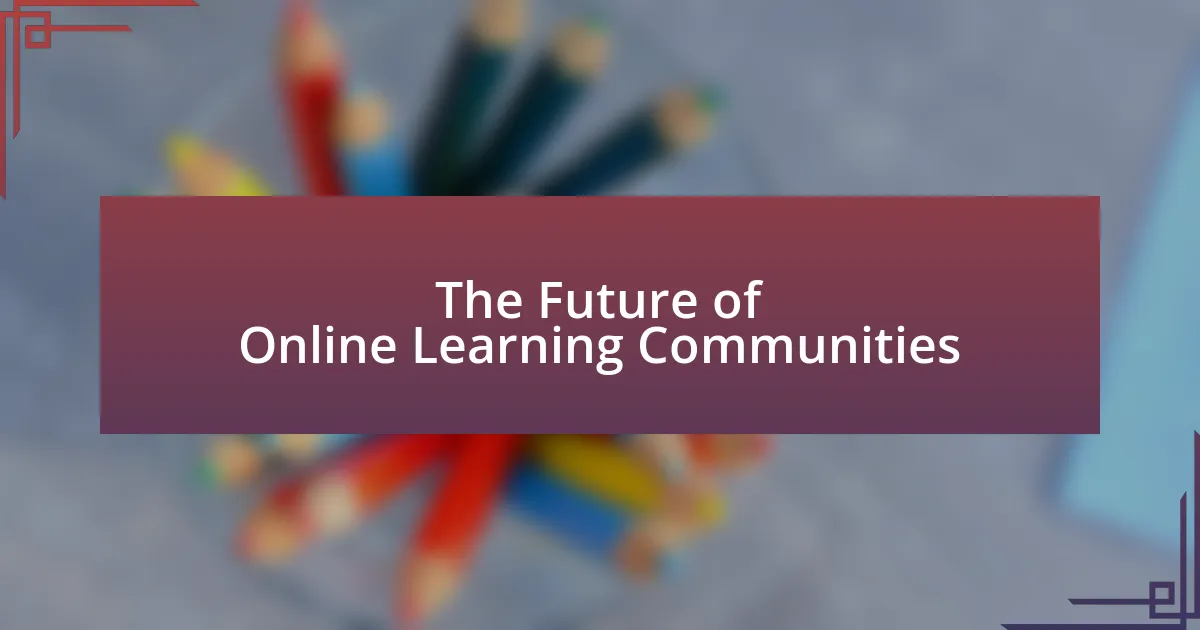The article analyzes the effectiveness of Virtual Reality (VR) in learning environments, highlighting its role in enhancing engagement, retention, and comprehension among students. It discusses how VR provides immersive and interactive experiences that facilitate deeper understanding of complex subjects, supported by research indicating improved learning outcomes compared to traditional methods. Key features of VR, such as experiential learning opportunities and interactive simulations, are examined, along with its applications in various educational fields, including medical training and language learning. The article also addresses challenges related to cost, accessibility, and technological barriers, while outlining best practices for effective implementation in educational settings.
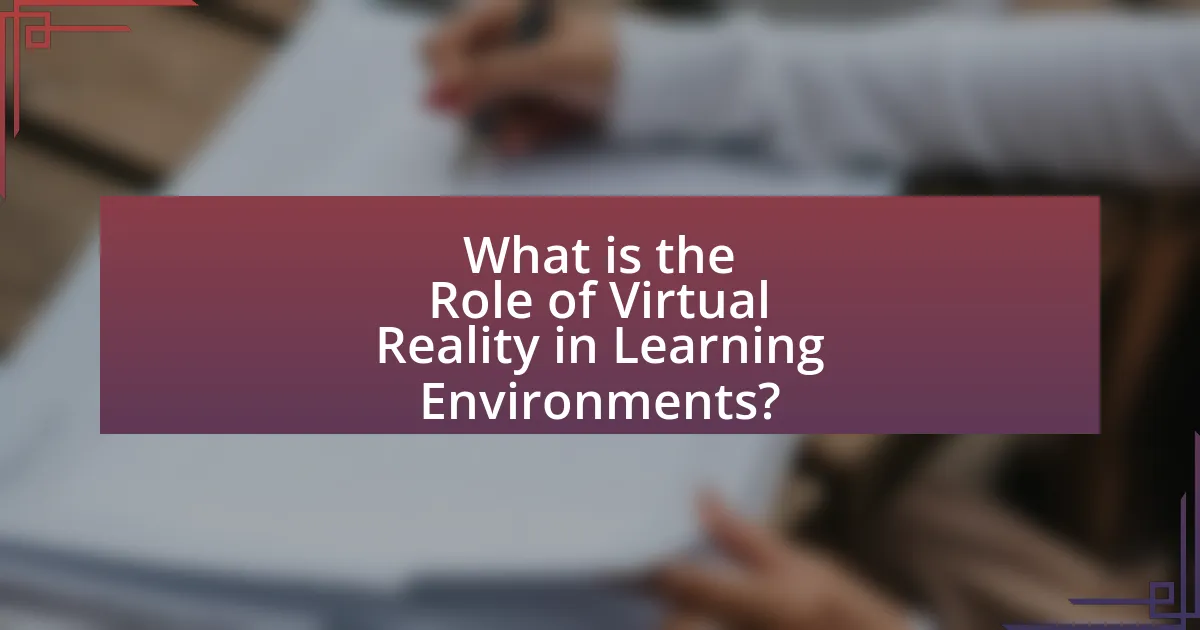
What is the Role of Virtual Reality in Learning Environments?
Virtual reality (VR) enhances learning environments by providing immersive, interactive experiences that facilitate deeper understanding and engagement. Research indicates that VR can improve retention rates and comprehension by allowing learners to visualize complex concepts in a simulated environment. For instance, a study published in the journal “Computers & Education” by Mikropoulos and Natsis (2011) found that students using VR for science education demonstrated significantly higher learning outcomes compared to traditional methods. This evidence supports the role of VR as a transformative tool in educational settings, enabling experiential learning that traditional classrooms may lack.
How does Virtual Reality enhance the learning experience?
Virtual Reality enhances the learning experience by providing immersive, interactive environments that facilitate deeper engagement and understanding of complex subjects. This technology allows learners to visualize and manipulate 3D models, conduct virtual experiments, and experience scenarios that would be impossible or impractical in a traditional classroom setting. Research conducted by the University of Maryland found that students using VR for learning retained information 40% better than those in conventional learning environments, demonstrating the effectiveness of VR in improving knowledge retention and comprehension.
What are the key features of Virtual Reality that support learning?
The key features of Virtual Reality that support learning include immersive experiences, interactive simulations, and experiential learning opportunities. Immersive experiences allow learners to engage in a 360-degree environment, enhancing focus and retention of information. Interactive simulations enable users to practice skills in a safe setting, promoting active learning and critical thinking. Experiential learning opportunities provide hands-on experiences that reinforce theoretical knowledge, making concepts more relatable and easier to understand. Research has shown that these features can lead to improved learning outcomes, as evidenced by a study published in the Journal of Educational Technology & Society, which found that students using VR for training scored significantly higher on assessments compared to traditional learning methods.
How does immersion in Virtual Reality affect student engagement?
Immersion in Virtual Reality significantly enhances student engagement by creating an interactive and immersive learning environment. Research indicates that students who participate in VR experiences demonstrate higher levels of motivation and interest in the subject matter compared to traditional learning methods. A study conducted by Mikropoulos and Natsis (2011) found that VR environments can lead to increased emotional involvement and cognitive engagement, resulting in improved learning outcomes. Furthermore, immersive experiences allow students to explore complex concepts in a hands-on manner, fostering deeper understanding and retention of information.
What are the different applications of Virtual Reality in education?
Virtual Reality (VR) has various applications in education, enhancing learning experiences through immersive environments. One significant application is in medical training, where VR simulations allow students to practice surgical procedures in a risk-free setting, improving their skills and confidence. Another application is in history education, where VR can transport students to historical events or locations, providing a deeper understanding of context and significance. Additionally, VR is used in language learning, enabling students to engage in interactive conversations with virtual characters, thereby improving their language skills in realistic scenarios. Research indicates that VR can increase student engagement and retention rates, with studies showing that learners using VR technology perform better in assessments compared to traditional learning methods.
How is Virtual Reality used in training and simulations?
Virtual Reality (VR) is used in training and simulations by creating immersive environments that replicate real-world scenarios, allowing users to practice skills and decision-making in a safe setting. For instance, VR is extensively utilized in fields such as aviation, where pilots can undergo flight simulations that mimic various conditions and emergencies without the risks associated with actual flying. Research indicates that VR training can enhance retention and engagement; a study published in the Journal of Educational Psychology found that learners in VR environments performed 30% better in skill retention compared to traditional training methods. This effectiveness stems from the ability of VR to provide experiential learning opportunities, enabling trainees to interact with their environment and receive immediate feedback.
What role does Virtual Reality play in remote learning environments?
Virtual Reality (VR) enhances remote learning environments by providing immersive, interactive experiences that facilitate engagement and comprehension. VR allows learners to explore complex concepts in a simulated environment, making abstract ideas more tangible. For instance, a study by Mikropoulos and Natsis (2011) found that students using VR for science education demonstrated improved understanding and retention of material compared to traditional methods. This immersive technology also fosters collaboration among remote learners, enabling them to interact in virtual spaces, which can lead to increased motivation and a sense of presence.
What challenges are associated with implementing Virtual Reality in learning?
Implementing Virtual Reality (VR) in learning faces several challenges, including high costs, technical limitations, and the need for specialized training. High costs arise from the expense of VR hardware and software, which can be prohibitive for educational institutions. Technical limitations include issues such as insufficient content availability and the need for robust infrastructure to support VR experiences. Additionally, educators often require specialized training to effectively integrate VR into their teaching methods, which can be a barrier to widespread adoption. These challenges hinder the seamless incorporation of VR into learning environments, impacting its overall effectiveness.
What are the technological barriers to using Virtual Reality in classrooms?
The technological barriers to using Virtual Reality in classrooms include high costs, limited access to hardware, and insufficient technical support. High costs are a significant barrier, as quality VR headsets and equipment can range from hundreds to thousands of dollars, making it difficult for many educational institutions to invest. Limited access to hardware is another challenge, as not all schools have the necessary infrastructure, such as powerful computers and internet connectivity, to support VR applications. Additionally, insufficient technical support can hinder the effective implementation of VR technology, as educators may lack the training needed to integrate VR into their teaching practices. These barriers collectively impede the widespread adoption of Virtual Reality in educational settings.
How do cost and accessibility impact the adoption of Virtual Reality in education?
Cost and accessibility significantly hinder the adoption of Virtual Reality (VR) in education. High costs associated with VR hardware, software, and content development create financial barriers for educational institutions, particularly those with limited budgets. For instance, a study by the International Society for Technology in Education found that schools often struggle to allocate funds for VR technology, which can exceed thousands of dollars per setup. Additionally, accessibility issues arise when considering the need for adequate infrastructure, such as high-speed internet and physical space for VR experiences. According to a report by the Pew Research Center, approximately 30% of U.S. households lack reliable internet access, further limiting the ability of students to engage with VR learning tools. These factors collectively restrict the widespread implementation of VR in educational settings, ultimately affecting its potential to enhance learning outcomes.
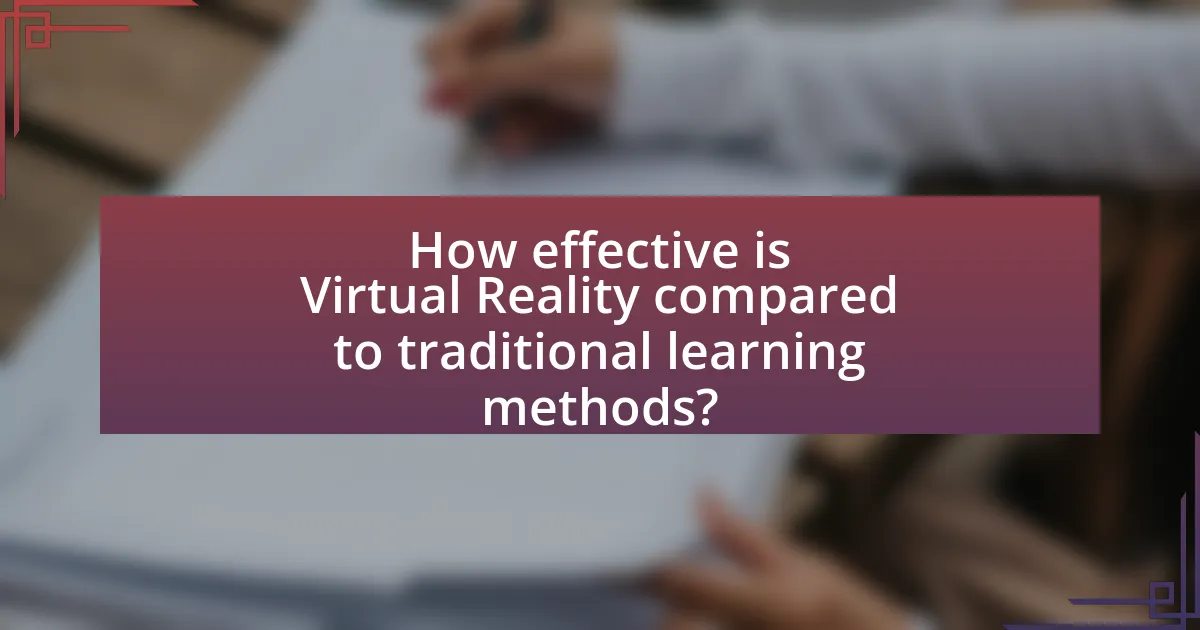
How effective is Virtual Reality compared to traditional learning methods?
Virtual Reality (VR) is significantly more effective than traditional learning methods in enhancing engagement and retention of information. Studies indicate that VR can increase knowledge retention rates by up to 75% compared to 10% for traditional lectures, as reported in a study by the University of Maryland. Additionally, VR provides immersive experiences that allow learners to practice skills in a safe environment, leading to improved performance in real-world applications. Research published in the journal “Computers & Education” found that students using VR scored 20% higher on assessments than those using conventional teaching methods. These findings demonstrate that VR not only enhances learning outcomes but also fosters a deeper understanding of complex subjects.
What research supports the effectiveness of Virtual Reality in education?
Research supports the effectiveness of Virtual Reality (VR) in education through various studies demonstrating enhanced learning outcomes. For instance, a study by Mikropoulos and Natsis (2011) published in the journal “Computers & Education” found that students using VR for learning complex scientific concepts showed significantly better understanding and retention compared to traditional methods. Additionally, a meta-analysis by Merchant et al. (2014) in “Computers & Education” reviewed multiple studies and concluded that VR can improve student engagement and motivation, leading to better academic performance. These findings collectively indicate that VR is a powerful tool for enhancing educational experiences.
How do learning outcomes differ between Virtual Reality and conventional methods?
Learning outcomes differ significantly between Virtual Reality (VR) and conventional methods, primarily due to the immersive and interactive nature of VR. Research indicates that VR enhances engagement and retention, leading to improved learning outcomes. For instance, a study by Mikropoulos and Natsis (2011) found that students using VR for science education scored 30% higher on assessments compared to those taught through traditional methods. This increase in performance is attributed to VR’s ability to simulate real-world scenarios, allowing learners to practice skills in a safe environment, which conventional methods often lack.
What metrics are used to measure the effectiveness of Virtual Reality in learning?
Metrics used to measure the effectiveness of Virtual Reality in learning include engagement levels, knowledge retention, skill acquisition, and user satisfaction. Engagement levels can be assessed through time spent in the VR environment and interaction frequency, indicating how immersed learners are. Knowledge retention is often measured through pre- and post-tests, showing the extent of information retained after VR experiences. Skill acquisition can be evaluated through performance assessments in simulations, demonstrating the practical application of learned skills. User satisfaction is typically gauged through surveys and feedback forms, providing insights into the learners’ experiences and perceived value of the VR training. These metrics collectively provide a comprehensive understanding of VR’s impact on learning outcomes.
What are the cognitive benefits of using Virtual Reality in learning?
The cognitive benefits of using Virtual Reality (VR) in learning include enhanced engagement, improved retention, and better spatial awareness. VR immerses learners in interactive environments, which increases motivation and focus, leading to deeper cognitive processing. Research indicates that immersive experiences can improve memory retention by up to 75% compared to traditional learning methods, as demonstrated in a study by Mikropoulos and Natsis (2011) published in the journal “Computers & Education.” Additionally, VR facilitates experiential learning, allowing learners to practice skills in a safe environment, which enhances problem-solving abilities and critical thinking.
How does Virtual Reality facilitate experiential learning?
Virtual Reality (VR) facilitates experiential learning by immersing learners in interactive, simulated environments that replicate real-world scenarios. This immersive experience enhances engagement and retention, as learners can practice skills and apply knowledge in a safe, controlled setting. Research indicates that VR can improve learning outcomes; for instance, a study published in the journal “Computers & Education” found that students using VR for training scored 30% higher on assessments compared to traditional methods. This evidence supports the effectiveness of VR in providing experiential learning opportunities that are both impactful and memorable.
What impact does Virtual Reality have on knowledge retention?
Virtual Reality significantly enhances knowledge retention by providing immersive and interactive learning experiences. Studies indicate that learners who engage with content in a virtual environment retain information better than those using traditional methods. For instance, research published in the journal “Computers & Education” by Mikropoulos and Natsis (2011) found that students using Virtual Reality for learning demonstrated a 30% improvement in retention rates compared to conventional instructional techniques. This effectiveness is attributed to the engaging nature of VR, which stimulates multiple senses and promotes active participation, leading to deeper cognitive processing and longer-lasting memory formation.
What feedback do educators and students provide about Virtual Reality in learning?
Educators and students generally provide positive feedback about Virtual Reality (VR) in learning, highlighting its immersive and engaging nature. Educators note that VR enhances student motivation and participation, as it allows for experiential learning that traditional methods cannot offer. For instance, a study published in the Journal of Educational Technology & Society found that 85% of educators reported improved student engagement when using VR tools in their classrooms. Students express excitement about the interactive experiences VR provides, which can lead to better retention of information. A survey conducted by PwC indicated that 75% of students felt more engaged in their learning when using VR compared to traditional learning methods. This feedback underscores the effectiveness of VR in creating dynamic learning environments.
What are common perceptions of Virtual Reality among educators?
Common perceptions of Virtual Reality among educators include its potential to enhance engagement and provide immersive learning experiences. Many educators believe that VR can facilitate experiential learning, allowing students to interact with content in a way that traditional methods cannot. Research indicates that 70% of educators see VR as a tool for improving student motivation and retention of information. Additionally, some educators express concerns about the cost and accessibility of VR technology, which may limit its widespread adoption in classrooms.
How do students feel about learning through Virtual Reality experiences?
Students generally feel positively about learning through Virtual Reality (VR) experiences. Research indicates that VR enhances engagement and motivation, with studies showing that 85% of students reported increased interest in subjects when taught through VR. Additionally, students often express that VR provides immersive experiences that facilitate better understanding of complex concepts, as evidenced by a study published in the Journal of Educational Technology & Society, which found that 78% of participants felt VR helped them grasp difficult material more effectively.
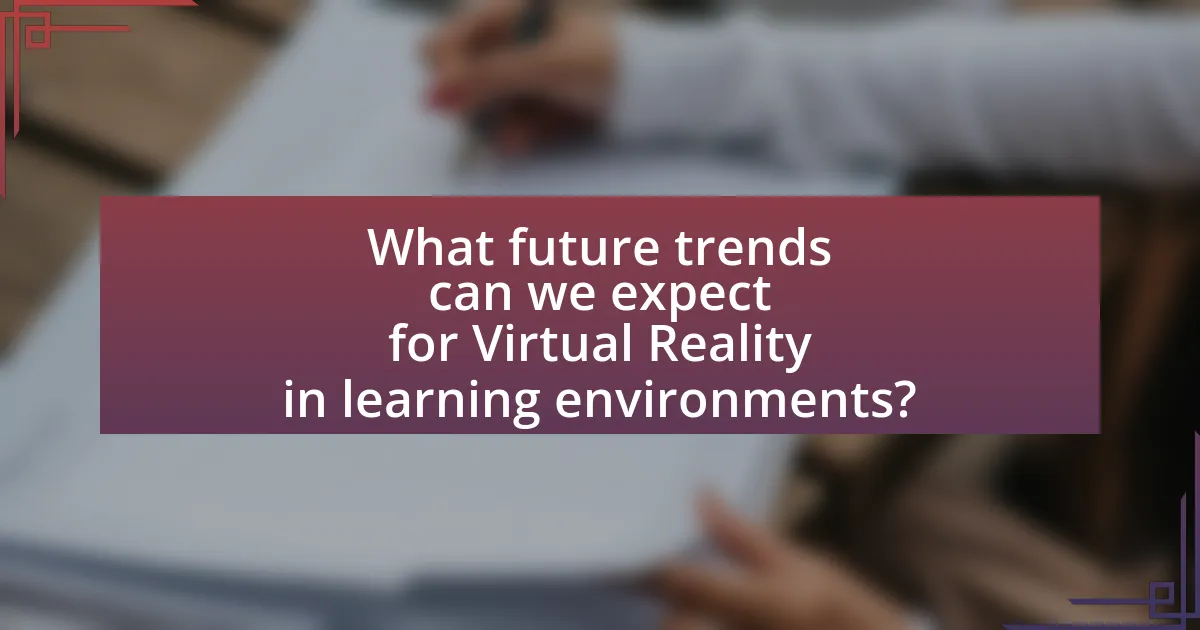
What future trends can we expect for Virtual Reality in learning environments?
Future trends for Virtual Reality in learning environments include increased integration of artificial intelligence, enhanced social interaction capabilities, and the development of more immersive and personalized learning experiences. Artificial intelligence will enable adaptive learning systems that tailor content to individual student needs, improving engagement and retention. Enhanced social interaction features will facilitate collaborative learning, allowing students to work together in virtual spaces, which has been shown to enhance problem-solving skills. Additionally, advancements in hardware and software will lead to more realistic simulations, making training in fields such as medicine and engineering more effective. These trends are supported by research indicating that immersive technologies can significantly improve learning outcomes, as evidenced by studies showing up to a 75% increase in knowledge retention when using VR compared to traditional methods.
How is technology evolving to enhance Virtual Reality in education?
Technology is evolving to enhance Virtual Reality (VR) in education through advancements in hardware, software, and content delivery methods. Innovations such as more powerful graphics processing units (GPUs) and lighter, wireless headsets improve user experience and accessibility, allowing for immersive learning environments. Additionally, the development of platforms like Oculus for Business and Google Expeditions provides educators with tools to create interactive lessons that engage students in experiential learning. Research indicates that immersive VR experiences can lead to improved retention rates and deeper understanding of complex subjects, as evidenced by a study published in the Journal of Educational Technology & Society, which found that students using VR scored 30% higher on assessments compared to traditional learning methods.
What advancements in hardware and software are on the horizon?
Advancements in hardware and software on the horizon include the development of more powerful graphics processing units (GPUs) and the integration of artificial intelligence (AI) in virtual reality (VR) applications. Upcoming GPUs, such as those from NVIDIA’s next-generation architecture, promise to deliver significantly improved rendering capabilities, enhancing the realism of VR environments. Additionally, AI algorithms are being increasingly incorporated into VR software to create adaptive learning experiences that respond to individual user needs, as evidenced by research from Stanford University, which highlights AI’s role in personalizing educational content in immersive settings. These advancements are expected to significantly enhance the effectiveness of VR in learning environments.
How might artificial intelligence integrate with Virtual Reality for personalized learning?
Artificial intelligence can integrate with Virtual Reality to create personalized learning experiences by analyzing individual learner data and adapting content in real-time. This integration allows AI algorithms to assess a learner’s progress, preferences, and challenges within the VR environment, tailoring the educational material accordingly. For instance, a study by Chen et al. (2020) demonstrated that AI-driven VR platforms could adjust difficulty levels and provide customized feedback based on user interactions, enhancing engagement and retention. Such adaptive learning systems leverage machine learning techniques to optimize educational outcomes, making the learning process more effective and individualized.
What are best practices for implementing Virtual Reality in educational settings?
Best practices for implementing Virtual Reality (VR) in educational settings include ensuring alignment with curriculum objectives, providing adequate training for educators, and incorporating interactive and immersive experiences that enhance learning. Aligning VR content with specific learning goals ensures that the technology serves educational purposes effectively. Training educators is crucial, as studies indicate that teachers who are well-versed in VR technology can facilitate better learning outcomes. Additionally, interactive VR experiences have been shown to increase student engagement and retention, as evidenced by research from the University of Maryland, which found that students using VR for learning retained information better than those using traditional methods.
How can educators effectively integrate Virtual Reality into their curriculum?
Educators can effectively integrate Virtual Reality (VR) into their curriculum by aligning VR experiences with learning objectives and providing immersive, interactive environments that enhance student engagement. Research indicates that VR can improve retention rates by up to 75% compared to traditional learning methods, as it allows students to experience concepts in a three-dimensional space, facilitating deeper understanding. For instance, a study by Mikropoulos and Natsis (2011) published in the journal “Computers & Education” demonstrated that students using VR for science education showed significant improvements in knowledge retention and application. By incorporating VR simulations, educators can create realistic scenarios that promote critical thinking and problem-solving skills, making the learning experience more relevant and impactful.
What resources are available for training educators in Virtual Reality use?
Resources available for training educators in Virtual Reality (VR) use include online courses, workshops, and professional development programs. For instance, organizations like the International Society for Technology in Education (ISTE) offer specific courses focused on integrating VR into teaching practices. Additionally, platforms such as Coursera and edX provide access to courses from universities that cover VR applications in education. Research conducted by the University of Maryland highlights that educators trained in VR technology report increased engagement and improved learning outcomes among students, validating the effectiveness of these training resources.
What are common pitfalls to avoid when using Virtual Reality in learning?
Common pitfalls to avoid when using Virtual Reality in learning include inadequate content design, lack of clear learning objectives, and insufficient user training. Inadequate content design can lead to disengagement, as learners may find poorly designed VR experiences confusing or uninteresting. Lack of clear learning objectives can result in learners not understanding the purpose of the VR experience, diminishing its educational value. Insufficient user training can cause frustration and hinder effective use of the technology, as learners may struggle to navigate the VR environment. Research indicates that well-structured VR learning experiences significantly enhance retention and engagement, highlighting the importance of addressing these pitfalls.
How can educators ensure that Virtual Reality is used effectively and ethically?
Educators can ensure that Virtual Reality (VR) is used effectively and ethically by establishing clear learning objectives, selecting appropriate content, and implementing guidelines for responsible use. Clear learning objectives help educators align VR experiences with educational goals, ensuring that the technology enhances learning outcomes. Selecting content that is age-appropriate and culturally sensitive prevents exposure to harmful or misleading information. Additionally, implementing guidelines for responsible use, such as ensuring informed consent and promoting inclusivity, fosters an ethical environment. Research indicates that when educators follow these practices, VR can significantly enhance engagement and retention in learning environments, as evidenced by studies showing improved student performance in immersive learning scenarios.
What strategies can be employed to overcome resistance to Virtual Reality in education?
To overcome resistance to Virtual Reality in education, institutions can implement comprehensive training programs for educators. These programs should focus on demonstrating the practical applications and benefits of Virtual Reality, such as enhanced engagement and improved learning outcomes, supported by studies indicating that immersive experiences can increase retention rates by up to 75%. Additionally, providing access to pilot programs allows educators to experience Virtual Reality firsthand, fostering familiarity and reducing apprehension. Engaging stakeholders, including parents and administrators, through workshops that showcase successful case studies can further build support and alleviate concerns about technology integration.


